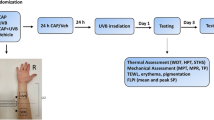Abstract
Capsaicin activates the transient receptor potential vanilloid 1 receptor (TRPV1) on small sensory afferents, and capsaicin is commonly used to elucidate mechanisms of neuropathic pain. This study was performed to describe changes in cold and cold pain perception after topically applied capsaicin. Fourteen healthy subjects were included. Cold detection and cold pain thresholds and the response to suprathreshold cold stimuli were evaluated before and after topical application of capsaicin (200 μl, 50 mg/ml in 70% ethanol solution, 10.2 cm2) for 30 min. The skin temperature was kept between 34 and 35°C. At the site of capsaicin application (the primary area), we found profound cold hypoesthesia and hypoalgesia, while outside the application site (the secondary area) there were no difference in the changes in cold detection and cold pain thresholds and cold-induced pain compared to the control arm. These results suggest a peripheral mediated decrease in cold sensation following TPRV1 receptor activation.



Similar content being viewed by others
References
Baron R (2000) Capsaicin and nociception: from basic mechanisms to novel drugs. Lancet 356:785–787
Bhave G, Zhu W, Wang H, Brasier DJ, Oxford GS, Gereau RW (2002) cAMP-dependent protein kinase regulates desensitization of the capsaicin receptor (VR1) by direct phosphorylation. Neuron 35:721–731
Brauchi S, Orta G, Salazar M, Rosenmann E, Latorre R (2006) A hot-sensing cold receptor: C-terminal domain determines thermosensation in transient receptor potential channels. J Neurosci 26:4835–4840
Culp WJ, Ochoa J, Cline M, Dotson R (1989) Heat and mechanical hyperalgesia induced by capsaicin-cross modality threshold modulation in human C nociceptors. Brain 112:1317–1331
Dirks J, Petersen KL, Rowbotham MC, Dahl JB (2002) Gabapentin suppresses cutaneous hyperalgesia following heat-capsaicin sensitization. Anesthesiology 97:102–107
Finnerup NB, Pedersen LH, Terkelsen AJ, Johannesen IL, Jensen TS (2007) Reaction to topical capsaicin in spinal cord injury patients with and without central pain. Exp Neurol 205:190–200
Gormsen L, Ribe AR, Raun P, Rosenberg R, Videbech P, Vestergaard P, Bach FW, Jensen TS (2004) Pain thresholds during and after treatment of severe depression with electroconvulsive therapy. Eur J Pain 8:487–493
Gottrup H, Juhl G, Kristensen AD, Lai R, Chizh BA, Brown J, Bach FW, Jensen TS (2004) Chronic oral gabapentin reduces elements of central sensitization in human experimental hyperalgesia. Anaesthesiology 101:1400–1408
Huang J, Zhang X, McNaughton PA (2006) Modulation of temperature-sensitive TRP channels. Semin Cell Dev Biol 17:638–645
Kenins P (1982) Responses of single nerve fibres to capsaicin applied to the skin. Neurosci Lett 29:83–88
Kilo S, Schmelz M, Koltzenburg M, Handwerker HO (1994) Different patterns of hyperalgesia induced by experimental inflammation in human skin. Brain 117:385–396
Klein T, Magerl W, Rolke R, Treede RD (2005) Human surrogate models of neuropathic pain. Pain 115:227–233
Kobayashi K, Fukuoka T, Obata K, Yamanaka H, Dai Y, Tokunaga A, Noguchi K (2005) Distinct expression of TRPM8, TRPA1, and TRPV1 mRNAs in rat primary afferent neurons with A delta/C-fibers and colocalization with trk receptors. J Comp Neurol 493:596–606
LaMotte RH, Shain CN, Simone DA, Tsai EF (1991) Neurogenic hyperalgesia: psychophysical studies of underlying mechanisms. J Neurophysiol 66:190–211
Linte RM, Ciobanu C, Reid G, Babes A (2007) Desensitization of cold- and menthol- sensitive rat dorsal root ganglion neurones by inflammatory mediators. Exp Brain Res 178:89–98
Liu B, Qin F (2005) Functional control of cold- and menthol- sensitive TRPM8 ion channels by phosphatidylinositol 4, 5-bisphosphate. J Neurosci 25:1674–1681
Magerl W, Wilk SH, Treede RD (1998) Secondary hyperalgesia and perceptual wind-up following intradermal injection of capsaicin in humans. Pain 74:257–268
Mohapatra DP, Nau C (2005) Regulation of Ca2+-dependent desensitization in the vanilloid receptor TRPV1 by calcineurin and cAMP-dependent protein kinase. J Biol Chem 280:13424–13432
Okazawa M, Inoue W, Hori A, Hosokawa H, Matsumura K, Kobayashi S (2004) Noxious heat receptors present in cold-sensory cells in rats. Neurosci Lett 359:33–36
Pud D, Yarnitsky D, Eisenberg E, Andersen OK, Arendt-Nielsen L (2006) Effects of cold stimulation on secondary hyperalgesia (HA) induced by capsaicin in healthy volunteers. Exp Brain Res 170:22–29
Reid G, Babes A, Pluteanu F (2002) A cold- and menthol- activated current in rat dorsal root ganglion neurones: properties and role in cold transduction. J Physiol 545:595–614
Simone DA, Baumann TK, LaMotte RH (1989) Dose-dependent pain and mechanical hyperalgesia in humans after intradermal injection of capsaicin. Pain 38:99–107
Torebjork HE, Lundberg LE, LaMotte RH (1992) Central changes in processing of mechanoreceptive input in capsaicin-induced secondary hyperalgesia in humans. J Physiol 448:765–780
Acknowledgments
This study was supported by the Danish Medical Research Council (no. 271–05-0060) and the Memorial Award of Gardener Ove William Buhl Olesen and wife Mrs. Edith Buhl Olesen.
Author information
Authors and Affiliations
Corresponding author
Rights and permissions
About this article
Cite this article
Callsen, M.G., Moller, A.T., Sorensen, K. et al. Cold hyposensitivity after topical application of capsaicin in humans. Exp Brain Res 191, 447–452 (2008). https://doi.org/10.1007/s00221-008-1535-1
Received:
Accepted:
Published:
Issue Date:
DOI: https://doi.org/10.1007/s00221-008-1535-1




